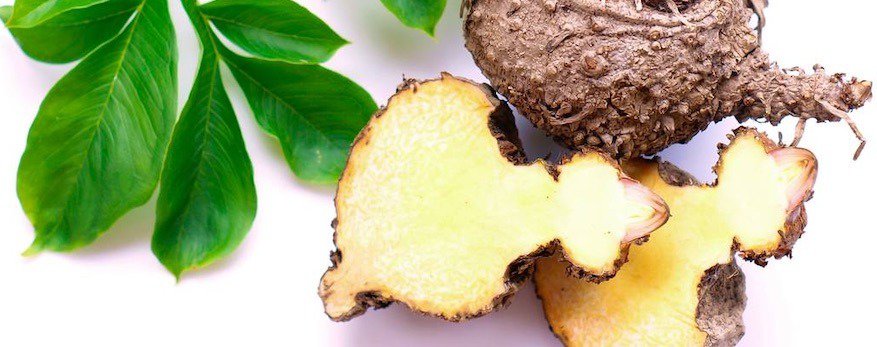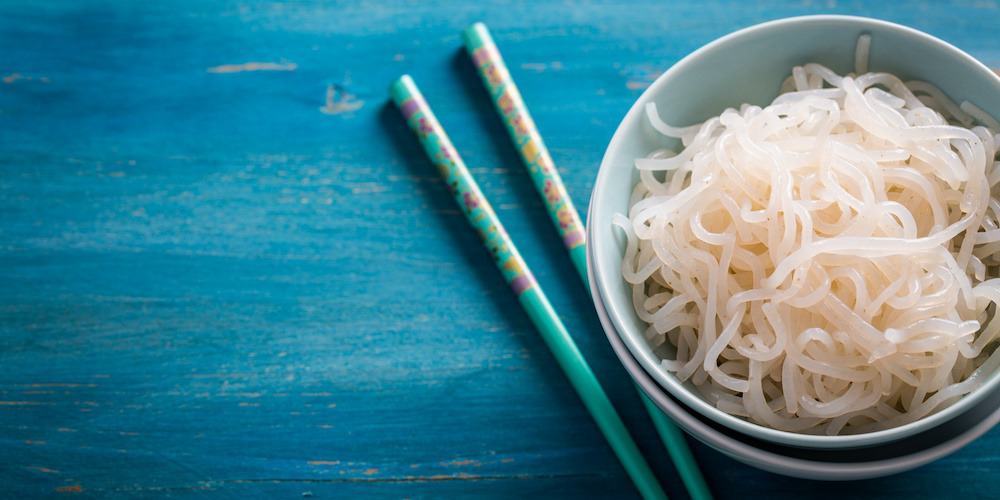BENEFITS OF KONJAC
✓ Helps with weight loss
✓ Relieves digestive disorders
✓ Improves diabetes
✓ Reduces cholesterol levels
✓ Detoxifies the body
What is konjac?
Konjac, scientifically known as Amorphophallus konjac, is a plant from the Araceae family. Native to Asia, it grows in the tropical forests of Vietnam, China, and Indonesia. It produces large leaves that can measure over a meter in height!
But it’s the bulb that has been used for culinary and medicinal purposes for centuries. The first traces of its use date back over 2000 years.
The plant remains an integral part of traditional Chinese medicine, where it is used to relieve respiratory disorders, burns, and skin problems.
The konjac bulb is consumed as a vegetable, cooked in the form of gelatinous paste (“konnyaku”), noodles (“shirataki”), or processed into flour.
Today, it is known and consumed worldwide for its slimming properties. Like chia seeds, psyllium, or spirulina, it acts as a natural appetite suppressant and promotes satiety. But it has many other qualities. Thus, it relieves digestive disorders, improves diabetes, reduces cholesterol levels, and detoxifies the body.
The bulbs are mainly used to produce flour. The 25,000 tons of flour produced each year are primarily intended for the food industry. Like guar gum, konjac is used in many foods as a thickening, gelling, and emulsifying additive (known as E425).
📚 Read also | Our guide to the best natural appetite suppressants
Nutritional Composition
- Vitamins: B6
- Carbohydrates
- Fibers: glucomannan
- Starch
- Water

The Benefits of Konjac
🏃🏻♂️ Helps with weight loss
Konjac consists of 30% water and 70% soluble fibers. Among them, glucomannan, a substance capable of absorbing up to 100 times its weight in water.
Once consumed, glucomannan transforms into a viscous gel that coats the stomach walls. Thus, it promotes satiety and has a satisfying action, ideal for limiting snacking during the day.
With only 3 kcal per 100 g, this plant is also one of the least caloric foods. Finally, by improving intestinal transit, it contributes to a flat stomach.
This study from Indiana University’s School of Medicine (USA) shows how konjac glucomannan helps with weight loss.
♻️ Relieves digestive disorders
Thanks to its richness in soluble fibers and water, konjac relieves certain digestive disorders, such as constipation. Indeed, its fibers improve stool consistency and facilitate their passage through the colon. Its bulb is particularly beneficial for lazy transit.
Moreover, it enhances the intestinal microbiota. Glucomannan acts as a prebiotic, promoting the growth of certain beneficial bacteria. Like carob or baobab, it notably increases the population of Lactobacillus and Bifidobacteria.
This study from Chung Shan Medical University (Taiwan), conducted on constipated patients, shows how konjac glucomannan promotes transit and improves intestinal microbiota.
🍭 Improves diabetes
The fibers contained in konjac also have a beneficial effect on type 2 diabetes. Indeed, they slow down the digestion of carbohydrates and prevent glycemic spikes after meals. Glucomannan lowers blood sugar levels and helps control blood glucose.
Finally, this food has the advantage of not containing sugar. Its glycemic index is not just low… It’s simply 0!
This study from West China University of Medical Sciences, conducted on diabetic patients, shows how konjac reduces blood glucose.
🍳 Lowers cholesterol levels
In various studies, konjac has shown beneficial effects in reducing blood cholesterol levels. It particularly lowers LDL cholesterol levels (or ‘bad cholesterol’) that accumulate in the arteries and is a cardiovascular risk factor.
This action is largely due to the glucomannan it contains. In addition to absorbing excess cholesterol, this soluble fiber traps bile salts produced by the liver from cholesterol. The organ is thus forced to produce more bile salts, drawing from the cholesterol reserves, preventing it from accumulating in the body.
This study from the University of Toronto (Canada) conducted in humans, shows how konjac glucomannan reduces cholesterol levels.
💎 Detoxifies the body
Konjac is interesting for eliminating toxins as part of a detox cure. Its fibers, which turn into a viscous gel, have the ability to capture toxins and ‘clean’ the walls of the intestine. Thus, it promotes the elimination of waste through the stool and frees the body from accumulated toxins.
But further studies are still needed to confirm the detoxifying action of konjac on the body.
👩🏻⚕️ Konjac and authorized health claims
EFSA, the European Food Safety Authority, authorizes certain health claims related to the consumption of konjac and glucomannan.
Thus, since 2009, it recognizes the benefit of glucomannan in maintaining normal cholesterol levels. EFSA also admits that it contributes to weight reduction as part of a low-calorie diet.
How to consume konjac?
Konjac in tablets
Konjac is mainly marketed in the form of tablets and capsules. They contain konjac bulb powder and are rich in glucomannan. This format is particularly interesting as part of a slimming diet. It is generally consumed as an appetite suppressant and taken before meals.
For satisfactory results, choose tablets or capsules sufficiently standardized in glucomannan (about 90%). They should preferably be additive-free and plant-based.
Konjac-based preparations
Konjac is a food that can easily be incorporated into the diet and is available in various forms. Thus, you can consume it in:
- konnyaku or konjac jelly, a gelatinous paste made from konjac flour and lime water. It is prepared in a frying pan or wok;
- shiratakis, Japanese noodles that can replace traditional pasta;
- konjac rice or gohan, in the form of grains;
- konjac flour, an interesting culinary aid for thickening and adding creaminess to preparations.
Konjac has a fairly neutral taste. So don’t hesitate to add spices and aromatic herbs. It is ideal as a side to meats, fish, or vegetables.

Sustainable consumption: prioritize organic and fair-trade konjac
✓ Most of the konjac available on the market comes from Asia. China and Japan are the world’s main producers. While China exports more than half of its production, Japan uses its production domestically.
✓ If possible, choose konjac grown organically and in areas away from pollution sources. Also, prioritize fair-trade channels to support the work of small producers. Do not hesitate to contact the manufacturer for more information on the origin of the products used.
Dosage
It is advised to consume between 120 and 150 g of cooked konjac per day (noodles, rice, etc.).
In capsule form, the recommended dosage is 1 to 3 capsules per day for capsules dosed at 750 mg. They should be taken with a large glass of water, at least 30 minutes before meals.
Contraindications and side effects
The consumption of konjac comes with certain contraindications :
- As a precaution, it is not recommended for pregnant and breastfeeding women and young children;
- People suffering from intestinal obstruction should avoid consuming it
- Its consumption can interact with certain medications and limit their absorption. Consult your doctor if you are on medication ;
- Diabetic individuals should seek advice from their doctor before consuming it.
Excessive consumption of konjac presents certain side effects :
- Gastrointestinal disorders
- Bloating
- Flatulence
- Diarrhea
If you experience side effects, stop your consumption and consult a doctor.
File prepared by Julia Perez
Sources and scientific studies
Melinda Chua, Timothy C Baldwin, Trevor J Hocking, Kelvin Chan, 2010. Traditional uses and potential health benefits of Amorphophallus konjac K. Koch ex N.E.Br.
D E Walsh, V Yaghoubian, A Behforooz, 1984. Effect of glucomannan on obese patients: a clinical study.
Hsiao-Ling Chen, Han-Chung Cheng, Wen-Tsu Wu, Yann-Jiu Liu, Su-Yuan Liu, 2008. Supplementation of konjac glucomannan into a low-fiber Chinese diet promoted bowel movement and improved colonic ecology in constipated adults: a placebo-controlled, diet-controlled trial.
C Y Huang, M Y Zhang, S S Peng, J R Hong, X Wang, H J Jiang, F L Zhang, Y X Bai, J Z Liang, Y R Yu, et al, 1998. Effect of Konjac food on blood glucose level in patients with diabetes.
Hoang Vi Thanh Ho, Elena Jovanovski, Andreea Zurbau, Sonia Blanco Mejia, John L Sievenpiper, Fei Au-Yeung, Alexandra L Jenkins, Lea Duvnjak, Lawrence Leiter, Vladimir Vuksan, 2017. A systematic review and meta-analysis of randomized controlled trials of the effect of konjac glucomannan, a viscous soluble fiber, on LDL cholesterol and the new lipid targets non-HDL cholesterol and apolipoprotein B.



